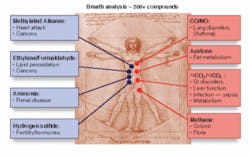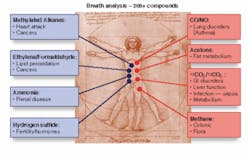Photon Forum: from blood to breath
Breath analysis may eventually replace blood and urine analysis to identify and diagnose early stage disease, according to Barbara Paldus, founder and chief technology officer of Picarro (Sunnyvale, CA). Speaking at last month's Photon Forum (Tucson, AZ) she noted that there are potentially more than 200 compounds that could be identified in human breath and that can indicate specific ailments ranging from lung disorders to renal disease (see figure).
Paldus was one of several presenters at the two-day conference who highlighted a general medical trend toward minimally or noninvasive approaches to disease detection and identification, many of them enabled by photonics technologies (biophotonics). Her comments were made during her discussion of Picarro's activities, which include development of a cavity-ring-down spectroscopy (CRDS) engine for use in clinical diagnostics. The CRDS technique brings benefits over traditional technologies in terms of selectivity, specificity, precision, and fast response times, she said.
Biophotonics was one of the growth areas identified by Donald Fraser, director of the Photonics Center at Boston University (Boston, MA). His opening address, "Opportunities in Optics," reflected the theme of the forum, which set out to identify and explain photonic opportunities for investors, CEOs, and chief technology officers. Fraser cited a report from Photonics Research Ontario that suggests the biophotonics marketplace could be $8 billion in 2005 with ongoing annual growth in the 12% to 20% range.
Other areas of opportunity highlighted by Fraser included solid-state lighting, displays, photonic sensors, and fiber to the "home/curb/desk." Although fairly optimistic about the long-term outlook for solid-state general illumination, Fraser pointed out that barriers like cost and low (white) light output remain, extending the time horizon beyond five years (see Laser Focus World, April 2004, p. 68). In the short term though, signage and traffic signal applications are already in place, while mobile applications are currently emerging in a variety of locations from military platforms to planes and ships.
Fraser expects worldwide sales of displays to grow about 70% between 2002 and 2005, with 2005 sales reaching $50 billion and representing about 60% of the total global photonics component marketplace. Despite such impressive numbers, North American suppliers are essentially not competing in the large-display business, he said, although emerging opportunities do exist for small displays and military applications that are being addressed by North American vendors. In the case of distributed-sensing technology, government funding and the enormous technology investments during the telecom boom have boosted the prospects for large-scale real-time smart sensing to provide control and protection of systems and facilities. Applications will likely include smart monitoring of dams and bridges as well as smart industrial processes.
Locals provide strong support
Co-organized by Breault Research Organization (BRO) and Laser Focus World, the Photon Forum enabled chief executive officers and senior technical officials from companies including Sony, Roche Pharmaceuticals, and JDS Uniphase to hear presentations on cutting-edge optical technologies and to mingle with venture-capital investors, explained Kathleen Perkins, CEO of Tucson-based BRO.
Although an international event with attendees from Europe and Asia, the conference garnered strong local support with attendees from several firms in the area, including Raytheon, NP Photonics, and Lasertel, as well as the Optical Sciences Center of the University of Arizona. The week of the conference was also declared "High-Tech Week in Tucson" by the city council and mayor Bob Walkup, who gave a lunchtime address at the forum. NP Photonics CEO Pat Edsell described the forum as "very worthwhile," noting that both the program content and the networking opportunities were "excellent." Jim Weisert of Lasertel was pleased with the exposure to cross-functional technology and the multiple opportunities for photonics manufacturers.
Other technical highlights of the conference included an overview of terahertz imaging by Don Arnone, CEO of TeraView (Cambridge, England), who described his company's terahertz product platform that is aimed at several imaging applications including 3-D imaging of pharmaceutical tablets for nondestructive quality control, security screening for explosives, and medical imaging for cancer; a look at noninvasive glucose monitoring by James Braig, CTO of OptiScan Biomedical (Alameda, CA), who predicted that within a decade the majority of glucose monitors will be optical, replacing current chemical sensors, and the improved accuracy will mean much better insulin control (and quality of life) for diabetics; and a discussion of new medical imaging methods by Jennifer Kehlet Barton, associate professor of Biomedical Engineering, Electrical and Computer Engineering, and Optical Sciences at the University of Arizona. After detailing confocal microscopy, optical coherence tomography, and fluorescence spectroscopy, Barton concluded by saying she expects to see the continuing evolution of optical imaging—in terms of resolution, sensitivity, and specificity—and that a major thrust will involve moving the technology from the bench to the bedside. Several other speakers alluded to this emerging concept of individualizing medical care at the bedside and cited the combination of lower costs and improved technology that will make such care a reality.
In summing up her reaction to the Photon Forum, Laser Focus World publisher Christine Shaw said she is pleased that both attendees and speakers responded positively to the event and, given its success, is looking forward to next year's forum—the date and location of which will be announced at www.photonforum.com as soon as they are finalized.

